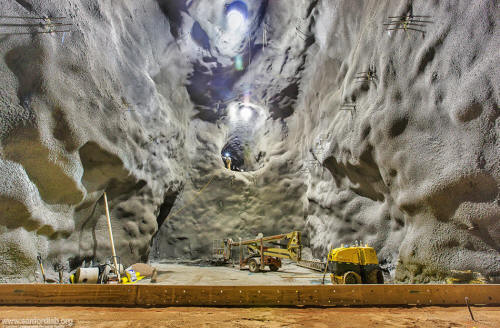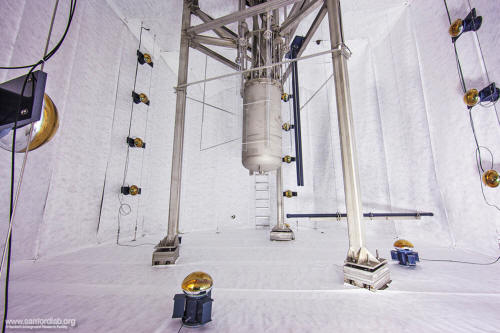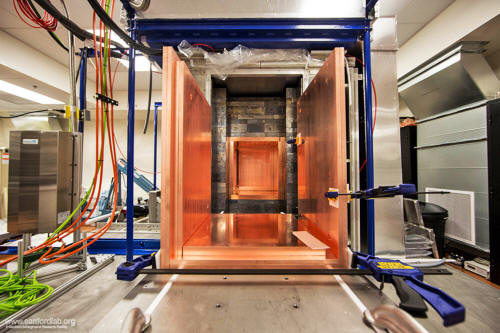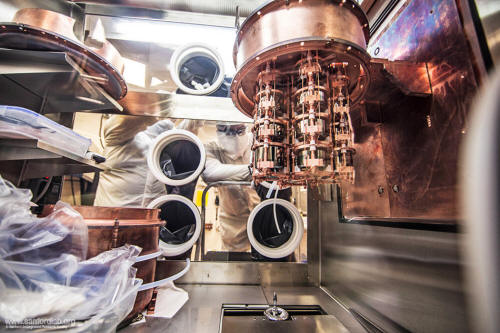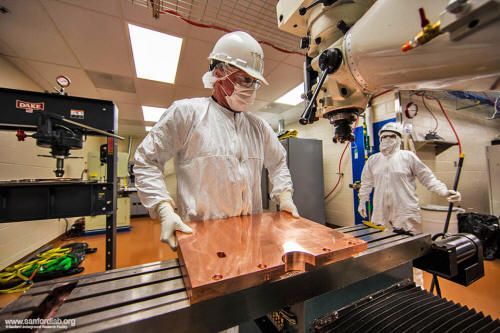|
by Constance Walter from Space Website
was once home to Ray Davis's Nobel Prize-winning solar neutrino experiment. The cavern has been enlarged, the walls coated in a spray-on concrete (shotcrete)
and outfitted for the
Large Underground Xenon (LUX) experiment.
© South Dakota
Science and Technology Authority
In 1969, Neil Armstrong fired my imagination when he took "a giant leap" onto the moon.
I was 11 years old as I watched him take that first step, and like millions around the world, I was riveted to the screen. Today I wonder how I would have reacted if the news anchor had simply described this incredible moment.
Would I have been so excited? So inspired? So eager to learn more? I don't think so. It was seeing the story unfold that made it magical, that pulled me into the story.
How we see the world impacts how we view it: That first glimpse of outer space sparked an interest in science. And although I didn't become a scientist, I found a career in science, working with researchers at Sanford Underground Research Facility (SURF) in Lead, South Dakota, explaining the abstract and highly complex physics experiments in ways the rest of us can appreciate. It isn't always easy.
Ever heard of neutrinoless double-beta decay? Probably not.
If I told you this rare form of nuclear decay could go a long way in helping us understand some of the mysteries of the universe, would you get the picture? Maybe.
The words are important, but an illustration or animation might give you a better idea.
Kathryn Jepsen, editor-in-chief of the physics magazine Symmetry, captured this need for the visual in this way:
And such visualizations can be profound.
Take a look at this operatic animation from Oak Ridge National Laboratory. Created using simulations run on the supercomputers at the National Center of Computational Sciences, it shows the expected operation of the ITER fusion reactor.
The video clearly outlines the objectives of the experiment, but the animation allows greater understanding as to how the fusion reactor could be used to create energy:
Digging deep into science bedrock
The Sanford Lab has many stories to tell: complex research experiments, a Nobel Prize, and a 126-year history as a mine, to name a few.
We write stories for a newsletter called Deep Thoughts, the Sanford Lab website and other publications. But we don't rely solely on words. Photographs and video play a big role in how we present the lab to the world.
Researchers at Sanford Lab go deep underground to try to answer some of the most challenging physics questions about the universe.
Going deep underground may help them answer these fundamental questions about the universe.
Here's how:
It turns out Sanford Lab is particularly suited to large physics experiments for another reason - the hard rock of the former Homestake Gold Mine is perfect for excavating the large caverns needed for big experiments.
From 1876 to 2001, miners pulled more than 40 million ounces of gold and 9 million ounces of silver from the mine.
In the beginning they mined with pickaxes, hammers and shovels - often in the dark with only candles for light. As they dug deeper, they brought wagons and mules underground to haul ore. Some animals were born, raised and died without ever seeing the sunshine.
By the early 1900s, Homestake was using locomotives, drills and lights.
By the early 1980s, the mine reached 8,000 feet, becoming the deepest gold mine in North America, with tunnels and drifts pocketing 370 miles of underground.
At its heyday, Homestake employed nearly 2,000 people, but as gold prices plummeted and operation costs soared, the company began decreasing operations and reducing staff.
Finally, in 2001, the Barrick Gold Corp., which owned the mine, closed the facility.
Five years later, the company donated the property to South Dakota for use as an underground laboratory.
That same year, philanthropist T. Denny Sanford donated $70 million to the project. Since then, the state has committed more than $45 million in funds to the project. Early on, South Dakota received a $10 million Community Development Block Grant to help rehabilitate the aging facility.
Part of the glamour of using Homestake to build a deep underground science laboratory was its history as a physics landmark. Starting in the mid-1960s, nuclear chemist Ray Davis operated his solar neutrino experiment 4,850 feet underground (designated the 4850 Level) of Homestake mine.
Using a 100,000-gallon tank full of perchloroethylene (fluid used in dry cleaning), Davis looked for interactions between neutrinos and the chlorine atoms, believing they would change into argon atoms.
Far from the mining activity, Davis worked for nearly three decades to prove the theory developed with his collaborator John Bahcall, professor of astrophysics in the School of Natural Sciences at the Institute for Advanced Study at Princeton.
The two proposed that the mysteries of the sun could be examined by measuring the number of neutrinos arriving on Earth from the sun.
By the 1970s, Davis proved the theory worked; however, there was a slight problem:
This led to the solar neutrino problem.
Scientists at underground laboratories around the world wanted an answer to this riddle.
Eventually, the mystery was solved by researchers in two separate experiments:
As it turns out, neutrinos are pretty tricky characters, changing "flavors" as they travel through space, oscillating between electron, muon and tau neutrinos.
Davis's detector was only able to see the electron neutrino.
In 2002, Davis's groundbreaking research earned him the Nobel Prize in Physics - energizing physicists to lobby for a laboratory on the hallowed ground at the abandoned Homestake Mine.
(This year, Takaaki Kajita of Super-Kamiokande and Arthur McDonald of SNOLab shared the Nobel Prize in Physics for their discoveries of neutrino oscillation.)
A one-of-a-kind (incredibly deep) hole
Because of the site's rich physics history and unique structure, South Dakota and many scientists lobbied to have a billion-dollar deep underground laboratory at the mine, as deep as 7,400 feet - and in 2007 the U.S. National Science Foundation (NSF) selected it as the preferred site for a proposed Deep Underground Science and Engineering Laboratory (DUSEL).
But in 2010, the National Science Board decided not to fund further design of DUSEL.
Physicists, citizens and politicians immediately began seeking other funding sources, and in 2011, the U.S. Department of Energy (DOE), through the Lawrence Berkeley National Laboratory, agreed to support ongoing science operations at Sanford Lab, while investigating how to use the underground research facility for other longer-term experiments.
Today, Sanford Lab hosts three large physics experiments nearly a mile underground on the 4850 Level.
The Large Underground Xenon (LUX) experiment, is looking for dark matter, which makes up most of the matter in the universe, but has yet to be detected. We can't see or touch dark matter, but we know it exists because of its gravitational effects on galaxies and clusters of galaxies.
Scientists with LUX use a vessel filled with one-third of a ton of liquid xenon, hoping that when a weekly interacting massive particle, or WIMP, strikes a xenon atom, detectors will recognize the signature.
In October 2013, after an initial run of 80 days, LUX was named the most sensitive dark-matter detector in the world.
LUX watertank just before it was filled with 70,000 gallons of deionized water. Credit: Matthew Kapust, Sanford Underground Research Facility,
© South Dakota
Science and Technology Authority
The Majorana experiment brings us back to that obscure-sounding neutrinoless double-beta decay.
Neutrinos, among the most abundant particles in the universe, are often called "ghost" particles because they pass through matter like it isn't there.
Scientists with the Majorana experiment hope to spot the rare neutrinoless double-beta decay phenomenon, which could reveal if neutrinos are their own antiparticles.
The inner copper shielding for the Majorana Demonstrator experiment is actually made of two layers of copper. The outermost layer is the purest copper that can be purchased commercially. The inner layer of copper is the purest in the world. It was "grown" by electroforming in a lab underground at Sanford Lab. Credit: Matthew Kapust, Sanford Underground Research Facility, © South Dakota Science and Technology Authority
The answer to this question could help us understand why humans - and, indeed, the universe - exist.
Majorana needs an environment so clean it was built almost entirely out of copper, electroformed deep underground, and it uses dozens of detectors made of enriched germanium crystals (76Ge) in its quest.
The detectors are built in an ultraclean "glove box," which is purged periodically with nitrogen gas, to ensure not even a single speck of dust will touch the highly sensitive detectors. When completed, the strings of detectors are placed inside a copper vessel that goes into a layered shield for extra protection against the environment.
CASPAR (Compact Accelerator System for Performing Astrophysical Research) researchers are studying the nuclear processes in stars.
Essentially, the goal is to create the same reactions that happen in stars a bit "older" than our sun. If researchers can do that, it could help complete the picture of how the elements in our universe are built.
The experiment is undergoing calibration tests and will go online in early 2016.
But can you see the science?
Do you have a picture in your mind of each of these experiments? Is it the right picture? It's not easy.
Writers want the public to clearly understand why the science is important. And so we look for images that will complement our stories.
Delicate work assembling the Majorana cryostat is done inside a glovebox. The cryostat contains strings of hockey puck shaped germainium detectors. Credit: Matthew Kapust, Sanford Underground Research Facility, © South Dakota Science and Technology Authority
Matt Kapust is the creative services developer at Sanford Lab (the two of us make up the entire communications team).
Since 2009, Kapust has been documenting the conversion of the mine into a world-leading research laboratory, using photography and video to record each stage of construction and outfitting.
Film is important for other reasons, as well.
Sanford Lab receives $15 million year for operations each year from the DOE.
In addition to the $40 million given to support the lab in 2007, South Dakota recently gave the lab nearly $4 million for upgrades to one of the shafts.
The individual experiments receive millions of dollars in funding from NSF and DOE, and a proposed future experiment, the Long Baseline Neutrino Facility and associated Deep Underground Neutrino Experiment (LBNF/DUNE) is expected to cost $1 billion.
All of this comes from taxpayers. And they want to know where their money is going - and why.
Our stories, if we do them right, create excitement and spur the public's collective imagination - I mean, we're talking about possibly discovering the origins of the universe!
When you think about it in those terms, a picture - or video - could be worth a million words, or a billion dollars.
Nailing down neutrinos
Kapust points to that billion-dollar experiment as an example.
LBNF/DUNE, currently in the planning stages, will be an internationally designed, coordinated and funded collaboration that will attempt to unlock the mysteries of the neutrino.
Billions of neutrinos pass through our bodies every second. Billions...
They are formed in nuclear reactors, the sun (a huge nuclear reactor) and other stars, supernovae and cosmic rays as they strike the Earth's atmosphere.
In particular, researchers with LBNF/DUNE want to more fully understand neutrino oscillations, determine the mass of these ghostly particles, and solve the mystery of the matter/antimatter imbalance in the universe.
To do this, they will follow the world's highest-intensity neutrino beam as it travels 800 miles through the Earth, from Fermilab in Batavia, Illinois, to four massive detectors on the 4850 Level of Sanford Lab.
And should a star go supernova while the experiment is running, the researchers could learn a lot more.
Depiction of the Long Baseline Neutrino Facility/Deep Underground Neutrino Experiment.
Credit: Fermilab
LBNF/DUNE will be one of the largest international megascience experiments to ever occur on U.S. soil.
The sheer scale of the experiment is mind-boggling.
For example, the detectors are filled with 13 million gallons of liquid argon, an element used in the SNOLab experiment that discovered neutrino oscillation. And more than 800,000 tons of rock will be excavated to create three caverns - two for the detectors and one for utilities. Each cavern will be nearly the length of two football fields.
That will require a lot of blasting, and engineers at Sanford Lab want to document the test blasts for a couple of reasons.
They want a graphic representation of what the blast will look like and they hope to catch any visual appearance of dust going down the drift. The huge experiment is being built near existing experiments and dust could have a negative impact.
Capturing the event on video could help them determine better ways to blast the rock to route the dust away from other sensitive physics experiments. As the experiment moves forward, our team will document each stage.
We can't bring visitors underground, but we can show them our progress.
Katie Yurkewicz, head of communications at Fermi National Accelerator Laboratory (Fermilab), said,
In our field, it's important to seek the expertise and interest of other communicators and the media.
In May 2015, a team from PRI's Science Friday arrived at Sanford Lab to do a story about LUX and the search for dark matter. The team spent three days filming underground and on the surface. They interviewed scientists, students and administrators.
The story was told on radio, of course, but the program also included a 17-minute video on Science Friday's website:
The radio program used sound, tone and words to great effect.
But the video takes viewers onto the cage and down the shaft, into a modern, well-lit laboratory, and on a locomotive ride through the dark caverns of the underground.
(Science Friday submitted the video for competition in the RAW Science Film Festival, which takes place Dec. 4-5 in Los Angeles.)
Setting the scenes
Producing film at Sanford Lab isn't easy.
Trips underground require careful planning, and even a trip action plan, part of a log that keeps track of everyone working underground. Should an emergency arise, the underground will be evacuated; the log ensures everyone gets to the surface safely.
Because we are required to spend a lot of time underground, we undergo regular safety training that adds up to several hours a year.
For every trip, we don restrictive clothing - hardhats as a safety measure and coveralls to keep dust from our clothing - then take an 11-minute ride in a dark cage, or elevator, to laboratories nearly a mile down. We lug our heavy lighting, sound and camera equipment with us, and shoot video in tight spaces.
If we forget something, we can't turn around and go back - the cage only runs at certain times of the day.
Bringing our lunch is a definite must. Once underground, we enter the cart wash area, where we remove our coveralls, don clean hardhats, and clean all of the equipment with alcohol wipes - we don't want to bring any dirt into the lab. Finally, we put booties over our shoes, then enter the laboratory area.
One big perk? There's an espresso machine and a panini press.
Recently, we did a story about the innermost portion of the six-layered shield around the Majorana Demonstrator project.
The shield gives the experiment extra protection from the radiation that permeates through the surrounding rock, especially radon, which can create noise in the experiment. The inner shield is special - it was made with ultrapure electroformed copper grown on the 4850 Level of Sanford Lab.
We interviewed physicist Vincent Guiseppe, the mastermind behind the shield, inside the deeply buried class-100 clean room where all the work is done.
Despite our precautions, we couldn't go into the clean room without putting on a "bunny suit":
It was a challenge, but it was worth it to get the story and a stunning image of the shield.
Randy Hughes works in a cleanroom machine shop nearly one mile underground. He machines all the copper parts for the Majorana Demonstrator experiment. Credit: Matthew Kapust, Sanford Underground Research Facility, © South Dakota Science and Technology Authority
While the lunar landing inspired my generation to look to the cosmos - and inspired me to want to fly to distant planets, see the Milky Way from a distant galaxy, and learn the secrets of the universe - none of us expected to be looking up from nearly a mile underground.
But with the right mix of sights and stories, science is inspiring a new generation, while searching for answers to universal questions using tools that are only now reaching for the stars.
|


